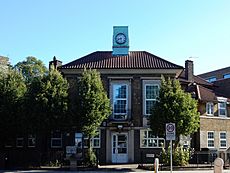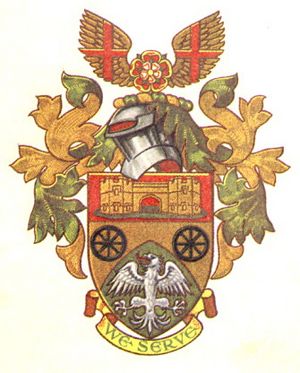Yiewsley and West Drayton Urban District facts for kids
| Yiewsley and West Drayton | |
| Motto: We Serve | |
 |
|
 |
|
| Geography | |
| Status | Urban district |
| 1911 area | 1,091 acres (4.4 km2) |
| 1961 area | 5,276 acres (21.4 km2) |
| HQ |
|
| History | |
| Created | 1911 |
| Abolished | 1965 |
| Succeeded by | London Borough of Hillingdon |
Quick facts for kids Demography |
|
|---|---|
| 1911 population - 1911 density |
4,315 3.9/acre |
| 1961 population - 1961 density |
23,723 4.5/acre |
| Politics | |
| Governance |
|
Imagine a special area in England called Yiewsley and West Drayton. For many years, from 1929 to 1965, it had its own local government. This area is now part of the London Borough of Hillingdon in Greater London.
Contents
How Yiewsley and West Drayton Grew
Yiewsley and West Drayton was once a local government area called an "Urban District." An Urban District was a type of local council that managed things like roads, lighting, and public health for towns.
Starting with Yiewsley
The story began with the Yiewsley Urban District. It was created on April 14, 1911. Before this, Yiewsley was part of a larger area called the Uxbridge Rural District. A "Civil Parish" is a small local area, and Yiewsley became its own Civil Parish in 1896.
Joining with West Drayton
On March 31, 1929, a big change happened. The nearby area of West Drayton joined with Yiewsley. This made the area larger, and its name changed to Yiewsley and West Drayton. The local council, which was like a mini-government, also grew. It now had 15 members to represent both Yiewsley and West Drayton.
Adding Harmondsworth
The area grew even more on March 31, 1930. The parish of Harmondsworth joined the Yiewsley and West Drayton Urban District. This new area included villages like Longford, Sipson, and Heathrow. With more people, the council grew again to 22 members.
In May 1930, a new Town Hall was opened in Yiewsley. This building was the main office for the local government. Later, after World War II, the Town Hall became too small. So, in 1952, the council moved its main office to Drayton Hall in West Drayton. This building was made even bigger in 1955.
The End of Yiewsley and West Drayton
In the early 1960s, the government decided to change how local areas were managed in London. A special group looked at all the areas, including Yiewsley and West Drayton.
They suggested creating fewer, but much larger, local areas. This led to a new law called the London Government Act 1963. On April 1, 1965, the Yiewsley and West Drayton Urban District officially ended. Its area became part of the new and much larger London Borough of Hillingdon.
Local Symbols: The Coat of Arms
Every important area often has a special symbol called a "coat of arms." The coat of arms for Yiewsley and West Drayton was given to them in 1953. It had different symbols that represented the area's history and features. For example, it included:
- Two cartwheels, showing the area's transport links.
- An eagle, which might represent the nearby Heathrow Airport.
- A gatehouse, which was a famous building in West Drayton.
- The motto "We Serve," showing the council's dedication to its people.
When the London Borough of Hillingdon was created, its own coat of arms used some similar ideas, like the eagle's wings and a Tudor rose.
How Many People Lived Here?
The population of Yiewsley and West Drayton grew a lot over the years:
| Year | 1911 | 1921 | 1931 | 1939 | 1951 | 1961 |
|---|---|---|---|---|---|---|
| Population | 4,315 | 4,843 | 13,066 | 16,132 | 20,468 | 23,723 |



